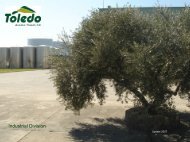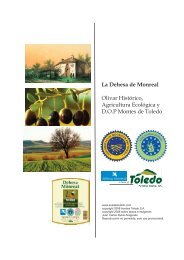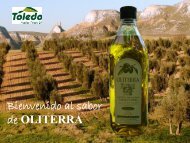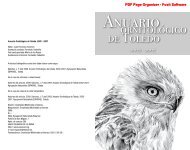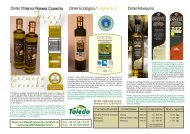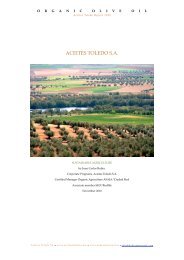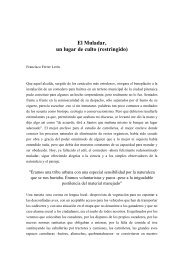On Olive Oil History and Facts. - Aceites Toledo SA
On Olive Oil History and Facts. - Aceites Toledo SA
On Olive Oil History and Facts. - Aceites Toledo SA
You also want an ePaper? Increase the reach of your titles
YUMPU automatically turns print PDFs into web optimized ePapers that Google loves.
<strong>Olive</strong> <strong>Oil</strong> <strong>History</strong> <strong>and</strong> <strong>Facts</strong><br />
Advantages <strong>and</strong> Disadvantages of the Old <strong>Olive</strong> Press<br />
Page 12<br />
Proper cleaning will produce higher quality oil. The grindstones, while ancient in design, are a<br />
good way to grind the olives because it breaks up the drupe's pulp while only slightly touching<br />
the nut <strong>and</strong> the skin. This reduces the release of the oil oxidation enzymes present in these<br />
organs. In addition, in this extraction method, the introduction of water is minimal when<br />
compared to the modern one, thus reducing the washing off of the polyphemols. The exhausted<br />
paste, called Pomace, has a low content of water making it an easier residue to manage.<br />
Advantages<br />
Better grinding of the olives, reducing the release of oil oxidation enzymes<br />
Reduced added water, minimizing the washing of polyphenols<br />
Pomace with a low content of water easier to manage<br />
Disadvantages<br />
Difficult cleaning<br />
Non continuous process with waiting periods thus exposing the olive paste to the action of<br />
oxygen <strong>and</strong> light.<br />
Requires more manual labour<br />
Longer time period from harvest to pressing.<br />
Modern Method – Decanter centrifugation<br />
The modern method of olive oil extraction uses an industrial decanter to separate all the<br />
phases by centrifugation. In this method the olives are crushed to a fine paste. This can be<br />
done by a hammer crusher, disc crusher, depitting machine or knife crusher.<br />
This paste is then malaxed for 30 to 40 min in order allow the small olive droplets to<br />
agglomerate. The aromas are created in these two steps through the action of fruit enzymes.<br />
Afterwards the paste is pumped in to an industrial decanter where the phases will be<br />
separated. Water is added to facilitate the extraction process with the paste.<br />
The decanter is a large capacity horizontal centrifuge rotating around 3000 rpm, the high<br />
centrifugal force created allows the phases to be readily separated according to their different<br />
densities (solids > vegetation water > oil). Inside the decanter's rotating conical drum there is a<br />
coil that rotates a few rpm slower, pushing the solid materials out of the system.<br />
Diagram of a working decanter. The three phases are separated according to their densities



